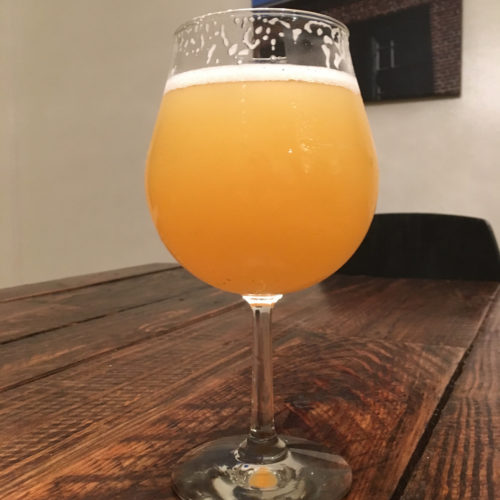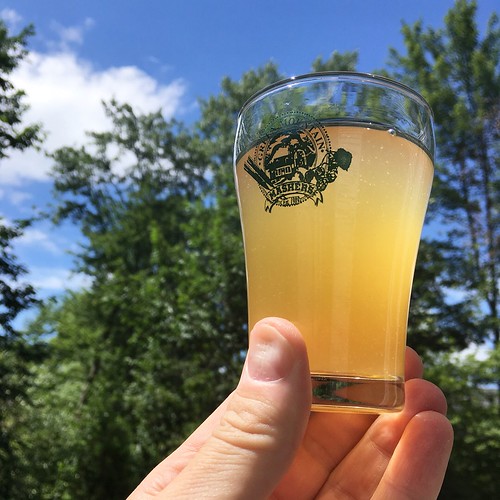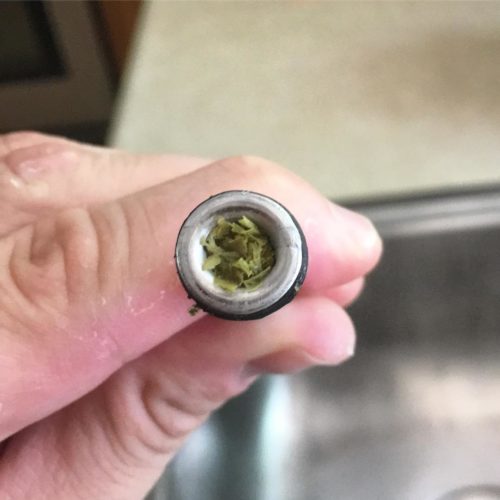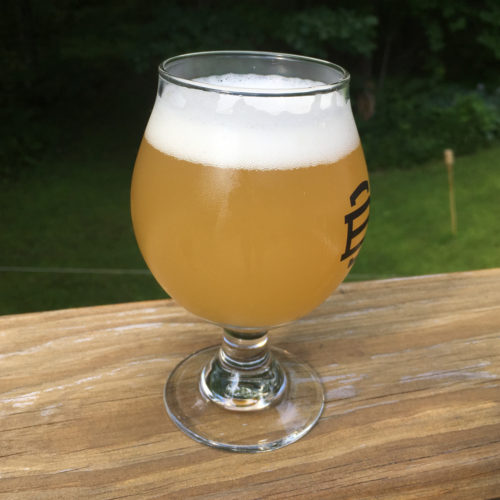Homebrew #65: Green Mountain Grisette (Mk. II)
¶ by Rob FrieselGiven the success of the first batch (second place Saison in the 2018 Greg Noonan Competition), I was determined to dial in my grisette recipe. Taking the feedback from the judges, and a little more speculative process tweaks from Markowski’s book, I applied those here to make Green Mountain Grisette (Mk. II):
The judges’ feedback was positive overall, but highlighted the following areas for improvement:
- Bitterness that was slightly too high and out of balance with the malt character
- A slight astringency that detracted from mouthfeel and flavor
- A slightly one-dimensional malt character
All three of these seemed actionable. I could achieve a more balanced bitterness by cutting back on the hops — no problem there. Cutting back on the hops might also help to de-emphasize or smooth out the edges on any astringent character left over after also better managing the mash pH management. (Probably. Maybe. I guess. 1) As for the malt character… I could change up some of the proportions maybe, but I didn’t want to go crazy with the grist here.
With respect to the malt character, rather than add a bunch of specialty grains, I thought I could better achieve that by using step mash. After all, Markowski talks about that in his book as being traditional.
Brew Day
I got a little bit of a late start that morning, but after sorting out a couple of things (one family schedule-related, the other being some grain mill drama 2) I was able to get the strike water going.
This would be a three-step mash: a 30 minute protein rest at 122°F then 30 minute beta rest at 144°F and finally a 30 minute alpha rest at 154°F.
Except a moment of distraction meant that I over-shot the original strike temperature. By like 30°F. At first I panicked a little bit. I didn’t want to just wait until the temperature came down — that could be… an hour? Mixing in cold water was an option but that would be more than just a little bit. Then it occurred to me that I still needed to measure out the water for the third infusion (the second infusion’s water was already in a pot on the stove). So I added cold water to the pot until I got down to my strike temperature, ran off water through the port and into a bucket until the kettle volume was down to where it needed to be, and finally mashed in.
Things went more smoothly with the mash after that. Heated the second and third infusions on the stove and then carefully carried them over to the kettle to pour them in. Pulled the bag at the end of the third rest and did the squeezing etc. that goes along with my brew-in-a-bag method.
I had exactly 7 gallons in the kettle at about 1.028. This was about 0.15 gallons more than I was supposed to have, but also about -0.005 from the gravity I was supposed to have. I did a little quick math and decided to extend the boil by about 15 minutes. Being a table-strength saison, it would be fine for the grisette to be a little light on gravity.
So I got it to boiling, spent some time to skim off the hot break 3, and added the bittering addition of Sterling after that first 15 minutes of vigorous boiling. The rest of the brew day was pretty by-the-numbers, even if I didn’t exactly hit the predicted numbers.
A 1.040 wort was OK by me given how it looked and tasted.
Brief Aside: Brew Day Retrospective
- Impact of the crush on mash efficiency? As I recall, a finer crush will aide in a higher mash efficiency. Putting aside any speculation about whether that contributes to astringency, I think my low gravity was in part a consequence of having to scramble with the grain mills and use the back-up with the larger gap. (I’ve since adjusted that gap.) Further reading: Waldron (2015) and Huolihan (2017).
- Impact of mash thickness on mash efficiency? Though crush size is probably a big contributor to my low mash efficiency on this batch, I don’t think it’s the only thing at play here. I’ve seen this before on lower gravity BIAB batches; I’ve started to come around to this idea that a thin mash for these lower gravity BIAB batches winds up with a scenario where the enzymes are “too dilute” and not making sufficient contact with the endosperm. I’ll need some more research on that, but I’d speculate that this is the other big contributor to missing my gravity. Further reading: Found (2016) and Mosher (2003).
- Getting the hang of these step mashes! The last couple of times I did a step mash, any infusions after the first were way off with respect to temperature. Those cases were definitely “user error” wherein I assumed I needed to do the infusion with boiling water instead of the 180°F or whatever it was that BeerSmith calculated. “How could that be right?” I wondered, as if I knew better. Well, this time around I heated those infusions to the stated temperatures (i.e., instead of to boiling) and got much closer to the step temperatures. As in, 1-2°F under instead of 5-10°F over.
- Getting a better sense of boil-off rates. Since moving from the stovetop to the garage, I’ve found that it’s been much harder for me to predict my boil-off rates. The Anvil burner is (obviously; desirably) much stronger than the ones in my kitchen stove. The problem has been that I don’t know how that “much stronger” translates into predicting evaporation during the boil. I keep track of my pre- and post-boil volumes, but those have been anywhere from 1 gallon per hour to 1.7 gallons per hour. Then it occurred to me that I haven’t been keeping track of where I set the dial. So I took a picture this time and resisted the urge to fidget with it. Hopefully this will help me to more accurately predict in the future. As in: “Put the dial here and you’ll have a boil-off rate of 1.3 gallons per hour.” (With the disclaimer that yes I realize there could be other factors influencing that rate.)
Fermentation
My previous batch of grisette fermented with Wyeast 3711 French Saison, which I really liked and looked forward to using again. Unfortunately, my local HBS was out of that strain when I went shopping. Because I tend to be a just-in-time shopper, and because I’d already planned the brew day, I looked for an alternative. They had a couple of saison strains in the refrigerator, but I ultimately went with White Labs WLP566 Belgian Saison II. I’d used it before and been reasonably satisfied with the results. Descriptions of their fermentation profiles seemed close enough and… well, they’re both apparently var diastaticus strains. 4
I over-built a starter to 1050 ml in volume. I pulled 400 ml of the starter as a sample for a future batch and pitched the rest — approximately 650 ml. The wort was 74°F when I pitched and I placed it in my fermentation chamber to chill it the rest of the way down to 68±1°F.
Within a few hours, the activity in the blow-off bucket was ridiculously strong — easily hundreds of bubbles per minute. The krausen was dense and creamy-looking. Certainly by the look of things, fermentation was off to a healthy start.
I removed the heater wrap from the carboy, and reset the ceiling on the controller to 78°F so that the beer could free-rise.
By +57 hours, gravity was down to 1.012. And then somewhere between +127 and +165 hours, it hit its final gravity of 1.007. So we’ll call that 6-7 days to fully ferment. Not too shabby.
I let it condition a couple more days, then added 3 oz. of Sterling to dry hop for a few days. Then I cold crashed the beer and racked it to a keg.
Woeful Aside About the Kegged Beer
Transferring this beer from the carboy to the keg seemed (at the time) to be pretty routine, and just like all the others in recent memory. After cold crashing, I moved it out of the refrigerator and let any of the disturbed sediment settle back down before siphoning. And yet somehow more than a little of the dry hop matter came over in the siphoning process. Not since my first dry hopping experience have a seen this much hop material come over into the package.
But again… I didn’t know that at the time. At the time it seemed like everything was going normal. The only hiccup seemed to be that I left behind about ¾ gallon of looks-like-drinkable-beer in the carboy because I was trying to keep the tip high enough to stay out of the sediment. I called this a loss rather than try to restart the siphon (again) because I thought everything had gone normally and I didn’t want to mess things up by stirring up the rather thick cake of trub at the bottom. (Also: I planned to send this beer to competition.)
It’s at this point that I seal up the keg, purge the headspace with CO₂, and put it on to burst carbonate. It got 18 hours at 45 PSI and then 8 hours at 50 PSI. 5 I partially purged the headspace and reduced the regulator to serving pressure (10 PSI in this case) and… I got a slow trickle of very foamy beer.
Not sure what to make of the situation, I reached out to some friends to ask for advice. They suggested that I…
- Shut off the gas and purge the headspace
- Remove the offending liquid-out post
- Replace it with a working liquid-out post
- Re-pressurize the keg
I did that but… got the same results. This time, rather than ask, I attempted to generalize. Could there be a clog upstream from the liquid-out post? Like maybe the dip-tube?
I would say that this helped, but I had to swap the dip-tube a second time before I started to get anything other than a foamy mass of hop sediment. And even then, I was pouring tiny sample glasses to look for the hop matter for at least 8 more days after that. 6
Anyway… Not a total loss. Not a dumper. But extremely frustrating. I guess I can take some comfort in the fact that at least I learned a couple of things.
Overall Impressions
I’m enjoying it, but it definitely suffered from what I can only assume are process flaws. I think I’ve got a good beer here, but it needs some more tweaking — in part on the ingredient side, in part on the process side — to get it right.
AROMA. Bready, floral, spicy. Malt character is moderately bready, like the inner-most part of a fresh pain paysan. Hops bring a moderate floral note that is a bit fleeting; you catch it and it presents fully, but then it’s gone. The spicy element is harder to pin down — there’s a background grainy-spicy that is probably from the rye and then a moderate foreground peppery-spicy that might be hops or might be yeast-derived phenols. No specific perceptible ester. No perceptible DMS. No perceptible diacetyl.
APPEARANCE. Straw-yellow in color, probably 2-3 SRM. Hazy to the point of being opaque; a permanent haze (i.e., doesn’t clear with warming, so probably proteins). Tall white head with dense foam and a long persistence. Some lacing on the glass. Some pours are marred by distracting bits of hop matter floating at the bottom. (Oh well.)
FLAVOR. Bready and peppery-spicy, with some mid-palate citrus and a retronasal floral note. Malt character is the most dominant aspect, with notes like light-colored bread running throughout. There’s a background graininess that contributes a rustic quality that I think adds to the overall impression, but it’s still lacking in some of the complexity I’m after. Hop character is (again) largely supportive, with some floral-over-herbal-spicy contributions that mostly present themselves mid-palate and retronasally. I get a citrusy component (Meyer lemon?) as well, which was absent in the aroma; I suspect this is an ester contribution. There are peppery-spicy notes as well, especially in the back of the mouth; I attribute these to desirable phenols, though some of it may be from the rye. It’s more balanced than the previous batch, with an assertive (but moderate) bitterness that lingers appreciably (but not over-long).
MOUTHFEEL. On the light side of medium. Moderately assertive bite from medium-high carbonation. No discernible alcohol. No creaminess. If there’s astringency… I’m not picking it up. 7 And then there’s the attenuation… it’s decidedly a dry beer, but it could be a little more crisp, a little more attenuated.
OVERALL IMPRESSION. A decent, though flawed grisette. Light and refreshing, but a little… well, if not one-dimensional then two-dimensional. Hop choices and balance seem right. Malts need the most work; what’s there isn’t bad or wrong but could use “something else” to bring that out. The big wild card for me is which yeast was the better one for this beer. Given that I changed up the rye/wheat proportions and knocked the hops back, it’s not exactly the same beer so it’s not an apples-to-apples comparison but… it’s my opinion that these different yeasts give different characters.
So given all that… changes for next time?
- Get back to 3711. I could use a second opinion on that — and we’ll see what the judges say — but WLP566 just… it wasn’t the same. I think 3711 is a better attenuator (though I observed that it took awhile to get there) and I like its ester and phenol production qualitatively better. Again, I need another opinion on this (hopefully from the same judge(s)? and/or people who sampled it?) but that’s my hot take.
- Fine tune the grist. Given the reading that I’ve done on the style, I don’t know that anyone can say definitively what a grisette malt character should be aside from having “a relatively high proportion of wheat”. At 20% I’d say that I’m at least flirting with that. 8 I suspect that as a “farmhouse” style, it could stand to have a little bit of something like spelt or millet thrown in to mix things up. But that said, I’d prefer to keep things simple if I can, because I think that’s better aligned with what these styles are about.
- Dial in that mash. I think the step mash was totally the right move. But I also think that my grains are well-modified enough that my protein rest was probably too long. Meanwhile my beta-amylase rest was too short. Oh and also: I should err on the side of a lower temperature mash, even if that means stretching it out longer. Alternatively, instead of a step mash, I might consider that “round-trip” mash schedule that Gordon Strong describes in the recipe for “Tom Fitzpatrick’s Last Saison” (Modern Homebrew Recipes, 2015).
- And those dry hops…? I’m not convinced that not dry hopping is the way to go here. The original batch was dry hopped it and scored well. This one plays well aroma and flavor-wise in that dimension also. I believe that it’s dry hopped with the right amount of the right varietal. I just need to keep them contained in such a way that I’m not bringing those stupid flecks of hop matter across. (So bummed about that!)
Recipe
The all-grain BIAB recipe for Green Mountain Grisette (Mk. II) is as follows:
Water Chemistry
Starting with the Champlain Water District profile as a base:
- 0.24 g/gal. gypsum
- 0.24 g/gal. calcium chloride
- 0.24 g/gal. Epsom salt
- 1.19 ml/gal. 88% lactic acid
| Ca | Mg | Na | SO₄ | Cl⁻ | HCO₃⁻ |
|---|---|---|---|---|---|
| 53.4 | 10.3 | 7.5 | 73.2 | 47.6 | 66.9 |
Mash Grains
- 4 lb. 2 oz. Peterson Quality Malt Provenance Pils
- 2 lb. 7 oz. Peterson Quality Malt Rye
- 1 lb. 10 oz. Briess White Wheat Malt 9
Hop Schedule
- 0.8 oz. Sterling (60 min.)
- 1 oz. Sterling (5 min.)
- 3 oz. Sterling (dry hop 3 days)
Yeast
White Labs WLP566 Belgian Saison II (650 ml starter)
Brew Day
- Collect 12.80 qt. water and heat to 129.7°F. Mash in; hold at 122°F for 30 minutes.
- Meanwhile, heat 9.00 qt. water to 180.8°F and add to main mash. Hold at 144°F for 30 minutes.
- Meanwhile, heat 8.00 qt. water to 184.4°F and add to main mash. Hold at 154°F for 30 minutes. No mash out.
- Remove filter bag from water. Squeeze filter bag to extract as much liquid as possible for wort. No sparge. Pre-boil volume should be 6.85 gallons.
- Bring to a boil. Boil for 60 minutes; follow hop schedule as described above.
- Cool to 68°F as rapidly as possible. Post-boil volume should be approx. 5 gallons.
- Aerate wort; pitch WLP566 yeast from starter.
- Start fermentation at 68°F.
Beyond Brew Day
- Start fermentation at 68±1°F. After visible signs of activity (e.g., krausen and/or airlock bubbles), allow temperature to free-rise up to 78°F.
- Allow fermentation to complete (approx. 2 weeks) at any temperature in the 68-78°F range.
- Add 3 oz. Sterling to dry hop 3 days.
- Cold crash. Do not fine with gelatin.
- Rack to a keg. Burst carbonate: 18 hours at 45 PSI + 8 hours at 50 PSI; vent headspace and serve at 14±1 PSI (give it 2-3 days to come into its prime).
- Enjoy!
Details
Green Mountain Grisette (Mk. II), a Grisette by Tilde Gravitywerks
| Original Gravity | 1.040 |
| Final Gravity | 1.007 |
| ABV | 4.3% |
| Attenuation | 82.0% |
| IBU | 29 |
| SRM | 3.1 |
| Links | Flickr |
- Long aside of a footnote here: I’ve been trying to tame the astringency dragon for… about a year now? It’s been cited as a flaw, usually with qualifiers such as “slight” or “somewhat”, on multiple competition beers in the last year. This has been tough feedback for me to process because it’s not a fault that I myself usually pick up in my own beers, though I can usually pick it out in other beers pretty consistently. What could be going on here? Based on what I’ve read, it could be anything from over-milled grain to too-high mash pH to over-hopping to over-mineralizing the water. I could do a whole separate blog post on astringency alone and maybe later I will, but… in the meantime, I guess go listen to episode 43 of the Brülosophy podcast and join me in a raising a skeptical eyebrow to this feedback, broadly speaking.[↩]
- The mill I had been using for the last few batches suddenly stopped working in a rather inexplicable way. The bit I’d been using to turn the main roller’s drive shaft didn’t fit snugly into the notch anymore. I couldn’t tell if I’d worn down the bit or the edge’s of the drive shaft’s notch. Luckily I’d just picked up a Barley Crusher second hand from a friend. I had to unjam the free-spinning roller on that mill, but I managed to get it going and all the grains milled. That said, I hadn’t adjusted the mill gap, so the crush wasn’t as fine as I usually like. Oh well, at least I didn’t have to bag the whole day.[↩]
- There was a lot of hot break for some reason.[↩]
- …for whatever that’s worth?[↩]
- Amusing aside: I’d been using this particular regulator on this kegerator for about 2 years without a clamp. In other words, the hose from the regulator to the gas-in coupler was just held in place snugly by the barb. I’d never really given it a second thought; it was working that way just fine so I left it as-is. So imagine my surprise when I bumped the pressure up from 45 to 50 PSI and that hose shot right off of the regulator’s barb. I managed to get everything shut down pretty quickly, so I probably didn’t lose too much CO₂ that way. But still — it was a real facepalm moment. Luckily I had the right size butterfly clamp I could use so… lesson learned.[↩]
- To be completely transparent: I’m not sure that this beer ever completely cleared itself of hop matter. After about 8-10 days it seemed like the beer was pouring reasonably clear into the taster glasses. As in: it was hazy with protein from the wheat and rye, but relatively clear of hop matter. So I busted out the shiny new BeerGun and bottled up a few for an up-coming competition. Later that night, I poured one to enjoy by the fire pit and… it had a couple of floaty hop matter bits in it. So who knows what’s actually in the bottles that went to competition. I guess I’ll just keep my fingers crossed and hope for the best.[↩]
- Full disclosure: I tend not to pick up on bitterness in my own beers (which I already mentioned in this post) — but here I’d like to add that that’s even when I’m specifically looking for it. This is probably the effect of bias. That said, with some bottles of the first batch, I did manage to pick up on it. So with that in mind, I think I managed to ease this down from where it was, astringency-wise. Again: if you believe in that sort of thing.[↩]
- By comparison, Gordon Strong’s recipe in the Style Profile article in the October 2017 issue of BYO uses 15%. Granted: that same recipe is just Belgian pale malt + wheat but no rye and hey I got dinged with the first batch for not having malt complexity? Caveat emptor.[↩]
- I went in looking for Peterson wheat malt, but my local HBS was out! That said, I wasn’t expecting to find Peterson rye malt, so I did pick up that and then just flipped the proportions on the fly.[↩]
About Rob Friesel
Software engineer by day. Science fiction writer by night. Weekend homebrewer, beer educator at Black Flannel, and Certified Cicerone. Author of The PhantomJS Cookbook and a short story in Please Do Not Remove. View all posts by Rob Friesel →3 Responses to Homebrew #65: Green Mountain Grisette (Mk. II)
Pingback: blending at the tap | found drama
Pingback: 2018 Brewing Retrospective | found drama






Leave a Reply